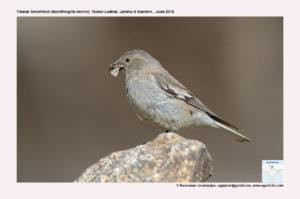Tibetan Snowfinch

Tibetan Snowfinch Montifringilla adamsi
Etymology:
- Montifringilla : Latin word montis – mountain; fringilla – finch
- Adamsi : Named after British amrmy doctor Andrew Leith Adams (1826–1882)
Vernacular Names: Tibetan: Richi-kya-shok, Abe je
Distribution in India: Resident of Northern Himalayas in India.
Description: Size of 16-17 cm. The nominate race has head grey-brown, faint paler supercilium and submoustachial streak, black chin and throat with small whitish feather tips. The upperparts are grey-brown with dark streaks, rump and uppertail-coverts are blackish-brown; median upperwing-coverts is dark brown with broad white fringes, greater coverts are white. The alula is dark brown, primary coverts is white with dark tips, primaries are blackish-brown with narrow pale edges, secondaries are blackish with whitish distal half. The tail is white, central feather pair are black, all rectrices are with black tip; underparts are creamy white, breast is washed buff; iris is brown; bill is horn-coloured, becoming black in breeding season; legs are black. The female has throat spot fainter, black of wings slightly browner. The juvenile is similar to adult, but warmer brown, with less white in wing, throat is greyish, yellow in bill base.
Habitat: It is found in high-altitude steppe country from above trees to snow-line; 2500–4500 m.
Food Habits: It eats seeds, buds, berries, and occasionally small insects. It forages high in trees, where often perches conspicuously at end of dead branch; also low down in bushes, shrubs and on ground. Usually in pairs and in small groups, post-breeding flocks may be mostly of males.
Breeding Habits: They breed in May-Aug in India. They have a pronounced circling display-flight with slowly fluttering wings. Bulky nest of dry grass and moss, lined with feathers and fine plant material, placed in crevice in rock face or hole in building, occasionally in burrow of small rodent; sometimes in artificial structure. It lays a clutch of 4–5 eggs. The incubation is done by female for a period of 12–14 days. The chicks are fed by both parents. The nestling period is 18–22 days and the fledglings fed by both sexes for 12–15 days after leaving nest.